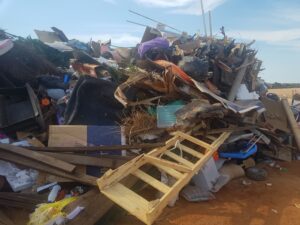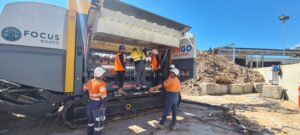As Australia strives toward a more circular economy, landfill operators and local governments face mounting pressure to do more with less—less space, fewer emissions, and less reliance on traditional disposal methods. Even with an increasing focus on resource recovery, recycling, and energy-from-waste, a significant portion of Australia’s waste stream still ends up in landfill.
In this environment, one technology stands out as a practical and impactful solution: pre-shredding waste before it is placed in landfill.


Proven Benefits: Less Volume, More Density, Longer Life
Recent operational data from a controlled three-week waste shredding study—conducted in collaboration with FOCUS enviro—has demonstrated the extraordinary benefits of introducing slow-speed shredding technology into landfill operations. The core objective of the study was to evaluate how shredding could reduce the volume of waste materials and increase bulk density, thereby extending the lifespan of landfill cells and reducing reliance on high-maintenance compactors.
The results were striking:
- Total waste volume was reduced by 61%, shrinking from 856m³ (pre-shred) to just 333m³ (post-shred) before compaction.
- Material density significantly increased, in some cases by over 600%—notably with materials such as mattresses and air filters.
- Landfill lifespan was extended by up to five years, representing an estimated capital saving of $7.8 million based on deferred cell development and reduced equipment wear.
| Material | Volume Reduction | Density Increase |
| C&D Waste | 63.9% | +177% |
| Tyres | 65.6% | +190% |
| HDPE | 47.1% | +89% |
| Air Filters | 71% | +345% |
| Mattresses | 83.3% | +600% |
In addition to physical efficiency gains, shredded waste was found to be easier to handle and compact, with significantly less littering and reduced bird and rodent interaction. Recoverable ferrous metals, often lost in general waste, were extracted at rates of up to 8 tonnes per day, creating a new income stream worth an estimated $18,000 per month.
Aligning with Australia’s Waste Policy
Australia’s National Waste Policy and Action Plan provide a clear roadmap: reduce waste generation, increase resource recovery, and minimise the use of landfill. Pre-shredding directly supports all three pillars. By improving compaction and enabling the recovery of valuable secondary materials, it helps landfills operate more efficiently and reduces the environmental footprint of waste disposal.
This is particularly relevant as Australia phases out the export of unprocessed waste materials and tightens the regulations around landfill performance. Pre-shredding is no longer a luxury—it is becoming an operational necessity.
A Smarter Way to Process Waste

The success of pre-shredding depends on the right equipment and expertise. That’s where FOCUS enviro comes in.
As a trusted partner for waste and resource recovery operators across Australia and New Zealand, FOCUS enviro provides proven, high-performance technology from world-class OEMs including:
- EDGE Innovate – Manufacturer of the VS420, a next-generation slow-speed shredder capable of tackling a wide range of bulky and abrasive materials with improved fuel efficiency and throughput.
- UNTHA – Global leaders in high-performance shredding for alternative fuels and engineered waste.
- M&K – Experts in screening, sorting and conveying systems that enhance recovery rates and streamline operations.
Together, these technologies enable operators to extract more value from waste, reduce reliance on landfill compactors, and increase throughput without increasing footprint.
FOCUS enviro also delivers full project support—from concept and commissioning through to aftersales and service—helping facilities future-proof their operations while meeting regulatory and commercial goals.


